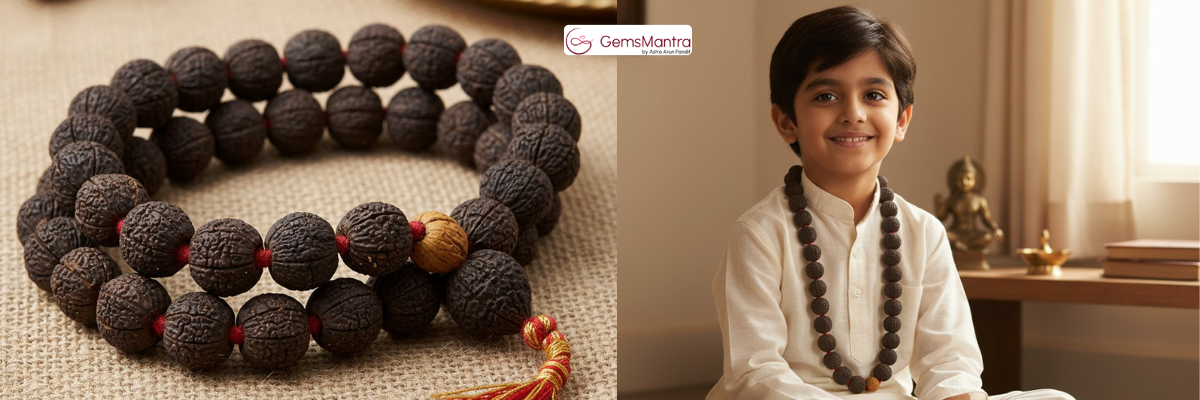
Rudraksha Vs Bhadraksha: Understanding the Differences and Benefits
In the world of spiritual healing and energy balancing, sacred beads have always held a special place. Among these, Rudraksha and Bhadraksha are widely revered for their unique spiritual, mental, and physical benefits.
But how many of us truly understand the difference between these two sacred gems? While both are natural seeds with profound metaphysical powers, they serve different purposes and have distinct properties. Knowing the difference between Rudraksha vs Bhadraksha helps you choose the right bead for your spiritual journey, well-being, and personal growth.
What is Rudraksha?
Rudraksha is a seed from the Elaeocarpus ganitrus tree, traditionally associated with Lord Shiva. Rudraksha, often called the “tear of Lord Shiva,” holds a sacred place in Hindu spirituality. According to ancient texts, when Lord Shiva opened his eyes after deep meditation, tears fell to the earth and became Rudraksha seeds.
Wearing Rudraksha is believed to connect the devotee with Shiva’s divine energy, symbolizing devotion, spiritual awakening, and a deep bond with the divine. Different types of Rudraksha beads, distinguished by their mukhis (faces), are associated with various aspects of spiritual practice and cosmic energies.
Origin and Botanical Identity
Rudraksha is the seed of the Elaeocarpus ganitrus tree, predominantly found in the Himalayan regions of Nepal, India, and Indonesia. The name "Rudraksha" translates to "the eye of Lord Shiva," signifying its divine connection. The tree is considered sacred in Hinduism, and its seeds are believed to have originated from the tears of Lord Shiva.
Key Features of Rudraksha
- Origin: Grown primarily in India, Nepal, and Indonesia.
- Appearance: Brown, rough-textured seeds with natural grooves called mukhi.
- Spiritual Significance: Helps in meditation, reduces stress, and balances chakras.
- Health Benefits: Believed to lower blood pressure, improve circulation, and enhance immunity.
Types of Rudraksha
Rudraksha beads are classified based on the number of natural lines or faces (mukhi) on the seed, ranging from 1 to 21 mukhis. Each type of rudraksha has its own specific benefits. For example:
- 1 Mukhi: Spiritual enlightenment and supreme consciousness.
- 5 Mukhi: General wellness, peace, and protection.
- 7 Mukhi: Prosperity and health.
What is Bhadraksha?
Bhadraksha, though similar in appearance to Rudraksha, comes from a different variety of tree and holds a different set of spiritual and healing powers. Bhadraksha, though less known than Rudraksha, is revered for its potent spiritual properties.
It is associated with Goddess Kali, symbolizing protection, courage, and the removal of negativity. The seeds, sourced from trees like Scaevola taccada and Lanceaefolius, are considered rare and hold high spiritual value.
Botanical Origins
Bhadraksha is derived from the seeds of trees belonging to the Goodeniaceae family, such as Scaevola taccada, Lanceaefolius, and Sikkimensis. These trees are primarily found in coastal regions of India and Sri Lanka. The seeds are flat, light in weight, and lack the natural holes characteristic of Rudraksha.
Key Features of Bhadraksha
- Origin: Found mainly in southern India and parts of Nepal.
- Appearance: Darker, sometimes blackish seeds with rough grooves; usually smaller and more compact than Rudraksha.
- Spiritual Significance: Protects against negative energies, enhances focus, and deepens meditation practices.
- Health Benefits: Known to relieve stress, improve mental clarity, and aid in spiritual awakening.
Unique Properties of Bhadraksha
- Strengthens aura and shields from negative vibrations.
- Deepens the wearer’s meditation and spiritual connection.
- Considered ideal for individuals practicing advanced spiritual disciplines.
Rudraksha Vs Bhadraksha: The Key Differences
While both beads are sacred and offer spiritual and health benefits, there are several key differences that set them apart. Understanding these differences can help you choose the right bead for your personal needs.
|
Feature |
Rudraksha |
Bhadraksha |
|
Botanical Source |
Elaeocarpus ganitrus |
Scaevola taccada, Lanceaefolius, Sikkimensis |
|
Shape & Appearance |
Oval or round with natural grooves (mukhis) |
Flat, small, compact, no natural holes |
|
Spiritual Association |
Lord Shiva |
Goddess Kali |
|
Origin / Region |
Himalayas, Nepal, India, Indonesia |
Southern India, coastal regions, Sri Lanka |
|
Rarity |
Widely available |
Rare and less common |
|
Symbolism |
Devotion, spiritual awakening, connection with Shiva |
Protection, courage, removal of negative energies, connection with Kali |
Conclusion
Rudraksha and Bhadraksha are more than just beads—they are sacred companions on a spiritual journey. Rudraksha, tied to Lord Shiva, inspires devotion and inner awakening, while Bhadraksha, connected to Goddess Kali, brings a sense of protection and courage. Knowing their differences helps you connect with their divine energy in a meaningful way, turning these seeds into symbols of faith, reverence, and spiritual guidance.




